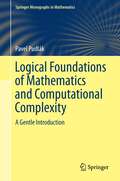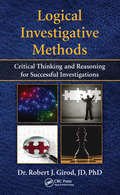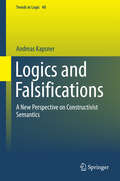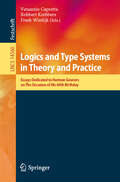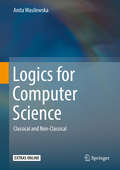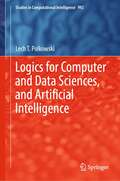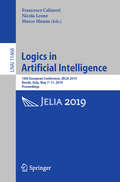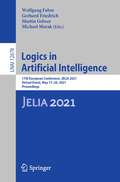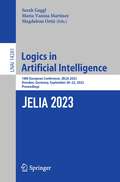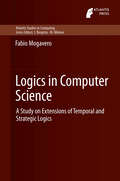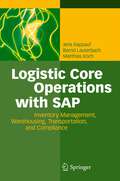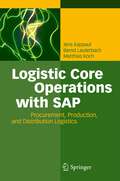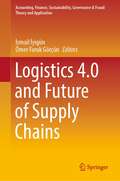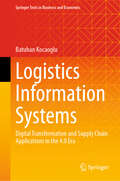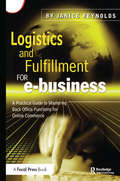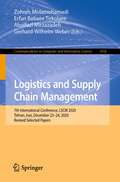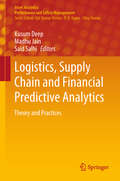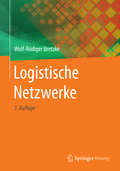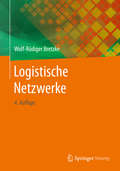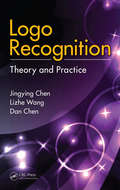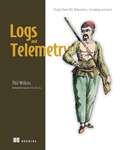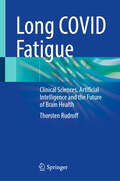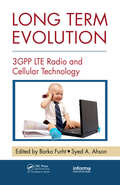- Table View
- List View
Logical Foundations of Mathematics and Computational Complexity
by Pavel PudlákThe two main themes of this book, logic and complexity, are both essential for understanding the main problems about the foundations of mathematics. Logical Foundations of Mathematics and Computational Complexity covers a broad spectrum of results in logic and set theory that are relevant to the foundations, as well as the results in computational complexity and the interdisciplinary area of proof complexity. The author presents his ideas on how these areas are connected, what are the most fundamental problems and how they should be approached. In particular, he argues that complexity is as important for foundations as are the more traditional concepts of computability and provability. Emphasis is on explaining the essence of concepts and the ideas of proofs, rather than presenting precise formal statements and full proofs. Each section starts with concepts and results easily explained, and gradually proceeds to more difficult ones. The notes after each section present some formal definitions, theorems and proofs. Logical Foundations of Mathematics and Computational Complexity is aimed at graduate students of all fields of mathematics who are interested in logic, complexity and foundations. It will also be of interest for both physicists and philosophers who are curious to learn the basics of logic and complexity theory.
Logical Investigative Methods: Critical Thinking and Reasoning for Successful Investigations
by Robert J. GirodThis book describes how to use logic, reasoning, critical thinking, and the scientific method to conduct and improve criminal and civil investigations. The author discusses how investigators and attorneys can avoid assumptions and false premises and instead make valid deductions, inductions, and inferences. He explains how tools such as interview and interrogation can be used to detect deception and profile unknown individuals and suspects. The book is aimed at improving not only the conduct of investigations, but also the logical use of cognitive, analytical, documentation, and presentation tools to win cases.
Logiciel de Rootage pour Kindle, Application, Outil: guide d’astuces pour une utilisation optimale de Kindle Fire
by Larry AlisonUn guide étape par étape sur la façon de rooter des appareils Kindle Sinon, la meilleure caractéristique des appareils Kindle est la possibilité de les rooter. Cela vous permettra d'accéder à tout contenu de votre choix, comme des émissions de télévision, des applications, de la musique et des films. Voici ce que vous obtiendrez: -Fonctionne pour tout appareil Kindle -À propos de l'enracinement -Comment rooter votre Kindle -Résolution des problèmes -Comment ajouter Google Play -Profitez de l'accès aux applications, films, musique et émissions de télévision
Logics and Falsifications
by Andreas KapsnerThis volume examines the concept of falsification as a central notion of semantic theories and its effects on logical laws. The point of departure is the general constructivist line of argument that Michael Dummett has offered over the last decades. From there, the author examines the ways in which falsifications can enter into a constructivist semantics, displays the full spectrum of options, and discusses the logical systems most suitable to each one of them. While the idea of introducing falsifications into the semantic account is Dummett's own, the many ways in which falsificationism departs quite radically from verificationism are here spelled out in detail for the first time. The volume is divided into three large parts. The first part provides important background information about Dummett's program, intuitionism and logics with gaps and gluts. The second part is devoted to the introduction of falsifications into the constructive account and shows that there is more than one way in which one can do this. The third part details the logical effects of these various moves. In the end, the book shows that the constructive path may branch in different directions: towards intuitionistic logic, dual intuitionistic logic and several variations of Nelson logics. The author argues that, on balance, the latter are the more promising routes to take. "Kapsner's book is the first detailed investigation of how to incorporate the notion of falsification into formal logic. This is a fascinating logico-philosophical investigation, which will interest non-classical logicians of all stripes. " Graham Priest, Graduate Center, City University of New York and University of Melbourne
Logics and Type Systems in Theory and Practice: Essays Dedicated to Herman Geuvers on The Occasion of His 60th Birthday (Lecture Notes in Computer Science #14560)
by Freek Wiedijk Venanzio Capretta Robbert KrebbersThis Festschrift, dedicated to Herman Geuvers on the occasion of his 60th birthday, contains papers written by many of his closest collaborators. Herman Geuvers is a full professor at Radboud University Nijmegen and holds a part-time professorship at Eindhoven University of Technology. He received his PhD from Radboud University in 1993 and he was promoted to full professor in Computer Assisted Reasoning in 2006. Prof. Geuvers is an internationally renowned researcher in the field of proof assistants, logic in computer science, lambda calculus, and type theory. He has been a steering committee chair of the TYPES and FSCD conferences, chair of related EU Cost Action projects, and program chair or editor of related conferences and special issues in the area of computer science logic. He is a successful, generous and inspiring advisor and educator. He has been director of education and director of research of the Computer Science Institute at Radboud University Nijmegen, and he is currently chair of the examination board of computer science and chair of the board of the Institute for Programming Research and Algorithmics, a Dutch national inter-university research school. The contributions in this volume reflect Prof. Geuvers’ main research interests.
Logics for Computer Science: Classical And Non-classical
by Anita WasilewskaProviding an in-depth introduction to fundamental classical and non-classical logics, this textbook offers a comprehensive survey of logics for computer scientists. Logics for Computer Science contains intuitive introductory chapters explaining the need for logical investigations, motivations for different types of logics and some of their history. They are followed by strict formal approach chapters. All chapters contain many detailed examples explaining each of the introduced notions and definitions, well chosen sets of exercises with carefully written solutions, and sets of homework. While many logic books are available, they were written by logicians for logicians, not for computer scientists. They usually choose one particular way of presenting the material and use a specialized language. Logics for Computer Science discusses Gentzen as well as Hilbert formalizations, first order theories, the Hilbert Program, Godel's first and second incompleteness theorems and their proofs. It also introduces and discusses some many valued logics, modal logics and introduces algebraic models for classical, intuitionistic, and modal S4 and S5 logics.The theory of computation is based on concepts defined by logicians and mathematicians. Logic plays a fundamental role in computer science, and this book explains the basic theorems, as well as different techniques of proving them in classical and some non-classical logics. Important applications derived from concepts of logic for computer technology include Artificial Intelligence and Software Engineering. In addition to Computer Science, this book may also find an audience in mathematics and philosophy courses, and some of the chapters are also useful for a course in Artificial Intelligence.
Logics for Computer and Data Sciences, and Artificial Intelligence (Studies in Computational Intelligence #992)
by Lech T. PolkowskiThis volume offers the reader a systematic and throughout account of branches of logic instrumental for computer science, data science and artificial intelligence. Addressed in it are propositional, predicate, modal, epistemic, dynamic, temporal logics as well as applicable in data science many-valued logics and logics of concepts (rough logics). It offers a look into second-order logics and approximate logics of parts.The book concludes with appendices on set theory, algebraic structures, computability, complexity, MV-algebras and transition systems, automata and formal grammars.By this composition of the text, the reader obtains a self-contained exposition that can serve as the textbook on logics and relevant disciplines as well as a reference text.
Logics in Artificial Intelligence
by Loizos Michael Antonis KakasThis book constitutes the proceedings of the 15th European Conference on Logics in Artificial Intelligence, JELIA 2016, held in Larnaca, Cyprus, in November 2015. The 32 full papers and 10 short papers included in this volume were carefully reviewed and selected from 88 submissions. The accepted papers span a number of areas within Logics in AI, including: belief revision, answer set programming, argumentation, probabilistic reasoning, handling inconsistencies, temporal logics and planning, description logics, and decidability and complexity results.
Logics in Artificial Intelligence: 16th European Conference, JELIA 2019, Rende, Italy, May 7–11, 2019, Proceedings (Lecture Notes in Computer Science #11468)
by Francesco Calimeri Nicola Leone Marco MannaThis book constitutes the proceedings of the 16th European Conference on Logics in Artificial Intelligence, JELIA 2019, held in Rende, Italy, in May 2019. The 50 full papers and 10 short papers included in this volume were carefully reviewed and selected from 101 submissions. Additionally, the book contains 3 invited papers. The accepted papers span a number of areas within Logics in AI, including: belief revision and argumentation; causal, defeasible and inductive reasoning; conditional, probabilistic and propositional logic; description logics; logic programming; modal and default logic; and temporal logic.
Logics in Artificial Intelligence: 17th European Conference, JELIA 2021, Virtual Event, May 17–20, 2021, Proceedings (Lecture Notes in Computer Science #12678)
by Gerhard Friedrich Wolfgang Faber Martin Gebser Michael MorakThis book constitutes the proceedings of the 17th European Conference on Logics in Artificial Intelligence, JELIA 2021, held as a virtual event, in May 2021. The 27 full papers and 3 short papers included in this volume were carefully reviewed and selected from 68 submissions. The accepted papers span a number of areas within Logics in AI, including: argumentation; belief revision; reasoning about actions, causality, and change; constraint satisfaction; description logics and ontological reasoning; non-classical logics; and logic programming (answer set programming).
Logics in Artificial Intelligence: 18th European Conference, JELIA 2023, Dresden, Germany, September 20–22, 2023, Proceedings (Lecture Notes in Computer Science #14281)
by Maria Vanina Martinez Magdalena Ortiz Sarah GagglThis book constitutes proceedings of the 18th European Conference on Logics in Artificial Intelligence, JELIA 2023, held in Dresden, Germany, in September 2023.The 41 full papers and 11 short papers included in this volume were carefully reviewed and selected from 111 submissions. The accepted papers span a number of areas within Logics in AI, including: argumentation; belief revision; reasoning about actions, causality, and change; constraint satisfaction; description logics and ontological reasoning; non-classical logics; and logic programming (answer set programming).
Logics in Computer Science: A Study on Extensions of Temporal and Strategic Logics
by Fabio MogaveroIn this monograph we introduce and examine four new temporal logic formalisms that can be used as specification languages for the automated verification of the reliability of hardware and software designs with respect to a desired behavior. The work is organized in two parts. In the first part two logics for computations, the graded computation tree logic and the computation tree logic with minimal model quantifiers are discussed. These have proved to be useful in describing correct executions of monolithic closed systems. The second part focuses on logics for strategies, strategy logic and memoryful alternating-time temporal logic, which have been successfully applied to formalize several properties of interactive plays in multi-entities systems modeled as multi-agent games.
Logistic Core Operations with SAP: Inventory Management, Warehousing, Transportation, and Compliance
by Bernd Lauterbach Jens Kappauf Matthias Koch"Logistic Core Operations with SAP" not only provides an overview of core logistics processes and functionality--it also shows how SAP's Business Suite covers logistic core operations, what features are supported, and which systems can be used to implement end-to-end processes in the following logistic core disciplines: Procurement, Distribution, Transportation, Warehouse Logistics and Inventory Management, and Compliance and Reporting. In this context the authors not only explain their integration, the organizational set-up, and master data, but also which solution fits best for a particular business need. This book serves as a solid foundation for understanding SAP software. No matter whether you are a student or a manager involved in an SAP implementation, the authors go far beyond traditional function and feature descriptions, helping you ask the right questions, providing answers, and making recommendations. The book assists you in understanding SAP terminology, concepts and technological components as well as their closed-loop integration. Written in a clear, straight-forward style and using practical examples, it contains valuable tips, illustrative screenshots and flowcharts, as well as best practices--showing how business requirements are mapped into software functionality.
Logistic Core Operations with SAP: Procurement, Production and Distribution Logistics
by Bernd Lauterbach Jens Kappauf Matthias Koch"Logistic Core Operations with SAP" not only provides an overview of core logistics processes and functionality--it also shows how SAP's Business Suite covers logistic core operations, what features are supported, and which systems can be used to implement end-to-end processes in the following logistic core disciplines: Procurement, Distribution, Transportation, Warehouse Logistics and Inventory Management, and Compliance and Reporting. In this context the authors not only explain their integration, the organizational set-up, and master data, but also which solution fits best for a particular business need. This book serves as a solid foundation for understanding SAP software. No matter whether you are a student or a manager involved in an SAP implementation, the authors go far beyond traditional function and feature descriptions, helping you ask the right questions, providing answers, and making recommendations. The book assists you in understanding SAP terminology, concepts and technological components as well as their closed-loop integration. Written in a clear, straight-forward style and using practical examples, it contains valuable tips, illustrative screenshots and flowcharts, as well as best practices--showing how business requirements are mapped into software functionality.
Logistics 4.0 and Future of Supply Chains (Accounting, Finance, Sustainability, Governance & Fraud: Theory and Application)
by İsmail İyigün Ömer Faruk GörçünThis book provides a detailed theoretical background of Logistics 4.0 using real-world examples and case studies and proposes a methodological framework to understand the technological revolutions happening in the present day from the perspective of logistics management. With the fourth industrial revolution, new technologies, such as artificial intelligence, cloud computing, 3D printers and the Internet of Things started to take greater prominence in the world of business. One of the sectors most affected by changes brought on by this Industry 4.0 is logistics, which has given rise to the concept of Logistics 4.0. Covering a wide range of topics on Logistics 4.0, such as warehousing, big data, 3D printing, robotics and cloud computing, this book would be a valuable read for those involved in logistics management, academics and students in the areas of supply chain management, logistics, industry 4, and big data. .
Logistics Information Systems: Digital Transformation and Supply Chain Applications in the 4.0 Era (Springer Texts in Business and Economics)
by Batuhan KocaogluIn today’s era of digital transformation, the logistics sector is one of the most technology-intensive industries. This book provides a comprehensive overview of the IT infrastructure required for company operations, the types of enterprise software used in logistics, and current data collection technologies. It addresses the terminology, information flows, and application contexts of the necessary software, helping readers to see the big picture without being overwhelmed by technical details. It explains principal methodologies for modelling and designing systems and describes the objectives of project management and system analysis, not to mention why they are so essential to developing information systems. It also defines critical terms before turning to sector-specific hardware and software solutions for logistics operations: data collection, data processing, and data analytics solutions. In addition, the book includes sections that introduce readers to programming and the core of the database, piquing their interest and guiding them to a higher level of specialization. Study questions are provided at the end of each chapter to test reader comprehension. This book will be a helpful resource for students in logistics or professionals working in the fields of business administration, foreign trade, industrial engineering, ERP, or MIS who want to advance their knowledge and skills in the logistics industry.
Logistics and Fulfillment for e-business: A Practical Guide to Mastering Back Office Functions for Online Commerce
by Janice ReynoldsLogistics and fulfillment management is unglamorous, complex and expensive, but it is one of the primary factors determining whether an e-business will be profitable. Many enterprises (large and small) rush into the e-business model without adequate consi
Logistics and Supply Chain Management: 7th International Conference, LSCM 2020, Tehran, Iran, December 23-24, 2020, Revised Selected Papers (Communications in Computer and Information Science #1458)
by Gerhard-Wilhelm Weber Zohreh Molamohamadi Erfan Babaee Tirkolaee Abolfazl MirzazadehThis book constitutes selected and revised papers from the 7th International Conference Logistics and Supply Chain Management, held in December 2020 in Tehran, Iran. Due to the COVID-19 pandemic the conference was held online. The 17 full papers and 2 short papers pressented were thoroughly reviewed and selected out of 70 submissions. The papers are organized in the topical sections on information technology in supply chain management; production/scheduling and transportation in supply chain management; sustainable and resilient supply chain management; humanitarian supply chain management.
Logistics, Supply Chain and Financial Predictive Analytics: Theory And Practices (Asset Analytics)
by Kusum Deep Madhu Jain Said SalhiThis book addresses a broad range of problems commonly encountered in the fields of financial analysis, logistics and supply chain management, such as the use of big data analytics in the banking sector. Divided into twenty chapters, some of the contemporary topics discussed in the book are co-operative/non-cooperative supply chain models for imperfect quality items with trade-credit financing; a non-dominated sorting water cycle algorithm for the cardinality constrained portfolio problem; and determining initial, basic and feasible solutions for transportation problems by means of the “supply demand reparation method” and “continuous allocation method.” In addition, the book delves into a comparison study on exponential smoothing and the Arima model for fuel prices; optimal policy for Weibull distributed deteriorating items varying with ramp type demand rate and shortages; an inventory model with shortages and deterioration for three different demand rates; outlier labeling methods for medical data; a garbage disposal plant as a validated model of a fault-tolerant system; and the design of a “least cost ration formulation application for cattle”; a preservation technology model for deteriorating items with advertisement dependent demand and trade credit; a time series model for stock price forecasting in India; and asset pricing using capital market curves. The book offers a valuable asset for all researchers and industry practitioners working in these areas, giving them a feel for the latest developments and encouraging them to pursue further research in this direction.
Logistische Netzwerke
by Wolf-Rüdiger BretzkeDer Autor stellt industriespezifische und branchenübergreifende logistische Designprinzipien für erfolgreiche Netzmodelle in den Bereichen Industrie, Handel und Transportdienstleistung vor. Für die 2. Auflage wurde u. a. die Analyse zum Thema Nachhaltigkeit vertieft, der Autor hat außerdem mit zusätzlichen Fallbeispielen und Schaubildern die Verständlichkeit verbessert und widmet den methodologischen Grundlagen jetzt ein eigenes Kapitel. Dadurch werden Wissenschaft und Praxis noch stärker miteinander verzahnt.
Logistische Netzwerke
by Wolf-Rüdiger BretzkeDie 4. Auflage dieses erfolgreichen Buches wurde vollständig neu bearbeitet. Themen wie Netzwerkmanagement und -konfiguration, Servicedesign, Multi-Channel-Logistik und Outsourcing werden behandelt. Besonders erwähnenswert sind die ausführliche Erörterung des grundlegenden Themas „Komplexität“ und die Neueinführung des Kapitels „Citylogistik“. Insgesamt trägt das Buch der Tatsache Rechnung, dass sich logistische Konzepte jedweder Art mehr denn je in einem komplexen und hochdynamischen Umfeld bewähren müssen. Das Verständnis dieses Umfelds und die Umsetzung der Konzepte und Ideen im Unternehmen, werden dem Leser durch vielfältige Praxisbeispiele erleichtert.
Logo Recognition: Theory and Practice
by Jingying Chen Lizhe Wang Dan ChenUsed by companies, organizations, and even individuals to promote recognition of their brand, logos can also act as a valuable means of identifying the source of a document. E-business applications can retrieve and catalog products according to their logos. Governmental agencies can easily inspect goods using smart mobile devices that use logo recognition techniques. However, because logos are two-dimensional shapes of varying complexity, the recognition process can be challenging. Although promising results have been found for clean logos, they have not been as robust for noisy logos. Logo Recognition: Theory and Practice is the first book to focus on logo recognition, especially under noisy conditions. Beginning with an introduction to fundamental concepts and methods in pattern and shape recognition, it surveys advances in logo recognition. The authors also propose a new logo recognition system that can be used under adverse conditions such as broken lines, added noise, and occlusion. The proposed system introduces a novel polygonal approximation, a robust indexing scheme, and a new line segment Hausdorff distance (LHD) matching method that can handle more distortion and transformation types than previous techniques. In the first stage, raw logos are transformed into normalized line segment maps. In the second stage, effective line pattern features are used to index the database to generate a moderate number of likely models. In the third stage, an improved LHD measure screens and generates the best matches. A comprehensive overview of logo recognition, the book also presents successful applications of the technology and suggests directions for future research.
Logs and Telemetry: Using Fluent Bit, Kubernetes, streaming and more
by Phil WilkinsBuild cloud native observability pipelines with minimal footprints and high-performance throughput—all with Fluent Bit, Kubernetes, and your favorite visualization and analytics tools.Logs and Telemetry is an all-practical guide to monitoring both cloud-native and traditional environments with the Fluent Bit observability tool. It takes you from the basics of collecting app logs, all the way to filtering, routing, enriching and transforming logs, metrics, and traces. Inside Logs and Telemetry you&’ll learn how to: • Deploy Fluent Bit for telemetry (log, metric, and trace) collection • Configure pipelines to filter, route, and transform data • Integrate Fluent Bit with containers and Kubernetes • Configure Fluent Bit to work with OpenTelemetry, Prometheus, and other open source tech • Monitor applications at scale with minimal footprint • Address challenges in Kubernetes-based ecosystems using Fluent Bit • Utilize Fluent Bit for real-time event analytics to derive new metrics and insights • Develop custom filters, inputs, and outputs for unique or reusable use cases Logs and Telemetry draws on both the input and support of key committers and founders of Fluent Bit, and author Phil Wilkins&’ years of experience in DevOps. Inside, you&’ll see how you can integrate Fluent Bit with Prometheus, OpenTelemetry, FluentD deployments, and more. Learn how Fluent Bit can not only meet all the demands of cloud-native use cases, but also more traditional deployments as well. About the technology Fluent Bit is a super-fast lightweight observability tool that&’s perfect for Kubernetes and containers, as well as traditional IT environments. Fluent Bit makes it a snap to extract meaning from the logs, traces, and other performance metrics generated by your applications and infrastructure. It&’s also a great way to route telemetry to analysis tools like Prometheus and Grafana. About the book Logs and Telemetry shows you how to turn systems data into actionable insights using Fluent Bit. You&’ll start by learning the pre-built plugins for common use cases and progress to integration with powerful tools like OpenTelemetry and real-time analytical event processing. You&’ll use plugins to configure routing, filtering and processing, automate your observability with Lua scripts, and configure Fluent Bit to meet the demands of highly scalable environments. What's inside • Deploy Fluent Bit for telemetry collection • Configure pipelines to filter, route, and transform data • Integrate Fluent Bit with containers and Kubernetes • Monitor applications at scale About the reader For developers, DevOps engineers, and SREs working with observability. About the author Phil Wilkins has spent over 25 years in the software industry from multinationals to software startups. He is the author of Logging in Action. The technical editor on this book was Karthik Gaekwad. Table of Contents Part 1 1 Introduction to Fluent Bit 2 From zero to &“Hello, World&” Part 2 3 Capturing inputs 4 Getting inputs from containers and Kubernetes 5 Outputting events 6 Parsing to extract more meaning 7 Filtering and transforming events Part 3 8 Stream processors for time series calculations and filtering 9 Building processors and Fluent Bit extension options 10 Building plugins 11 Putting Fluent Bit into action: An enterprise use case Appendix A Installations Appendix B Useful resources Appendix C Comparing Fluent Bit and Fluentd
Long COVID Fatigue: Clinical Sciences, Artificial Intelligence and the Future of Brain Health
by Thorsten RudroffThis book offers the first comprehensive analysis of long COVID fatigue using advanced neuroimaging and artificial intelligence (AI). It bridges the gap between basic science and patient care in post-viral syndromes. The volume guides readers from fundamental concepts to future innovations, making complex neurobiological mechanisms accessible to researchers and clinicians. Each chapter builds on the previous, connecting molecular mechanisms to clinical manifestations. The integration of AI in diagnosis and treatment is a pioneering approach in long COVID literature. The book provides detailed analysis of brain metabolic patterns in long COVID fatigue, insights into protective mechanisms like metabolic heterogeneity in the basal ganglia, practical guidelines for AI-enhanced diagnostic and treatment approaches, and pathways for translating research into clinical practice. It combines rigorous scientific analysis with practical applications, serving as both a reference and a roadmap for future developments in long COVID research and treatment. The main objectives are to provide a comprehensive understanding of long COVID fatigue mechanisms, present evidence-based approaches for diagnosis and treatment, showcase innovative AI applications in medical imaging, establish a framework for future research, and offer practical clinical management guidelines. This book is tailored for neurologists, neuroscientists, COVID-19 specialists, radiologists, healthcare providers, AI researchers, and graduate students in related fields.
Long Term Evolution: 3GPP LTE Radio and Cellular Technology
by Borko Furht Syed A. AhsonWhile 3G has been an outstanding success, the ever-growing demand for higher data rates and higher quality mobile communication services continues to fuel conflict between the rapidly growing number of users and limited bandwidth resources. In the future, a 100-fold increase in mobile data traffic is expected. That will necessitate further improvem
